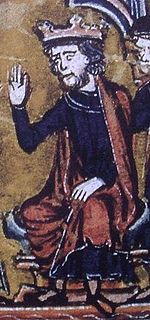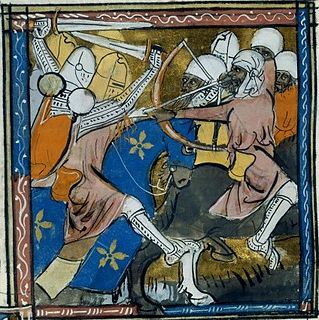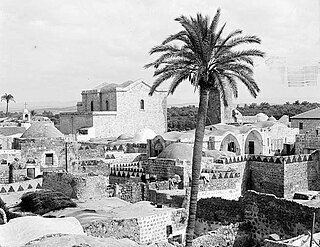Related Research Articles

Baldwin I also known as Baldwin of Boulogne, was the first count of Edessa from 1098 to 1100, and the first king of Jerusalem from 1100 to his death. Being the youngest son of Eustace II, Count of Boulogne, and Ida of Lorraine, he was destined for a church career, but he abandoned it and married a Norman noblewoman, Godehilde of Tosny. He received the County of Verdun in 1096, but he soon joined the crusader army of his brother Godfrey of Bouillon and became one of the most successful commanders of the First Crusade.
Bohemond II was Prince of Taranto from 1111 to 1128 and Prince of Antioch from 1111/1119 to 1130. He was the son of Bohemond I, who in 1108 was forced to submit to the authority of the Byzantine Empire in the Treaty of Devol. Three years later, the infant Bohemond inherited the Principality of Taranto under the guardianship of his mother, Constance of France. The Principality of Antioch was administered by his father's nephew, Tancred, until 1111. Tancred's cousin, Roger of Salerno, managed the principality from 1111 to 1119. After Roger died in the Battle of the Field of Blood, Baldwin II of Jerusalem took over the administration of Antioch. However, he did acknowledge Bohemond's right to personally rule the principality upon reaching the age of majority.

Baldwin II, also known as Baldwin of Bourcq or Bourg, was Count of Edessa from 1100 to 1118, and King of Jerusalem from 1118 until his death. He accompanied Godfrey of Bouillon, and Baldwin of Boulogne, to the Holy Land during the First Crusade. He succeeded Baldwin of Boulogne as the second count of Edessa when he left the county for Jerusalem following his brother's death. He was captured at the Battle of Harran in 1104. He was held first by Sökmen of Mardin, then by Jikirmish of Mosul, and finally by Jawali Saqawa. During his captivity, Tancred, the Crusader ruler of the Principality of Antioch, and Tancred's cousin, Richard of Salerno, governed Edessa as Baldwin's regents.

The Crusader states were feudal polities created by the Latin Catholic leaders of the First Crusade through conquest and political subterfuge. Four states were established: the county of Edessa (1097–1150); the principality of Antioch (1098–1287), the county of Tripoli (1102–1289), and the kingdom of Jerusalem (1099–1291). The kingdom of Jerusalem covered what is now Israel, the West Bank, the Gaza Strip, and adjacent areas. The other northern states covered what are now Syria, south-eastern Turkey, and Lebanon. The description 'Crusader states' can be misleading, as from 1130 very few of the Frankish population were crusaders. Medieval and modern writers have also used the term Outremer.

The Crusader state of the Kingdom of Jerusalem, created in 1099, was divided into a number of smaller seigneuries. According to the 13th-century jurist John of Ibelin, the four highest crown vassals in the kingdom proper were :
The Lordship of Ramla was one of the Crusader vassal states of the Latin Kingdom of Jerusalem. It has been vassal to and part of the County of Jaffa and Ascalon.
Eustace I Granier, also known as Eustace Grenier or Eustace Garnier, called in Latin Eustachius Granarius in the charters, was a nobleman from the Diocese of Thérouanne in the County of Saint-Pol who went to the Holy Land either during the First Crusade or around 1100. He became an influential retainer of King Baldwin I of Jerusalem, who granted the Lordship of Sidon and Lordship of Caesarea to him. After Baldwin II of Jerusalem was captured in April 1123 by Belek Ghazi, Eustace was elected Constable of Jerusalem and Bailiff of Jerusalem. Shortly before his death in 1123, he defeated a Fatimid army as the Battle of Yibneh near Ibelin.

The Crusades were a series of religious wars initiated, supported, and sometimes directed by the Latin Church in the medieval period. The term refers especially to the Eastern Mediterranean campaigns in the period between 1095 and 1271 that had the objective of conquering the Holy Land from Islamic rule. The term has also been applied to other church-sanctioned campaigns fought to combat paganism and heresy, to resolve conflict among rival Roman Catholic groups, or to gain political and territorial advantage. The difference between these campaigns and other Christian religious conflicts was that they were considered a penitential exercise that brought forgiveness of sins declared by the church. Historians contest the definition of the term "crusade". Some restrict it to only armed pilgrimages to Jerusalem; others include all Catholic military campaigns with a promise of spiritual benefit; all Catholic holy wars; or those with a characteristic of religious fervour.
Ramatha is the name of a former Roman Catholic titular bishopric in Palestine.
Roman of Le Puy, also known as Romanus of Puy, was the first lord of Oultrejordain in the Kingdom of Jerusalem from around 1120 to around 1126. He was a nobleman from Auvergne who accompanied Adhemar de Monteil, Bishop of Le Puy, to the Holy Land during the First Crusade. He signed royal charters during the reign of Baldwin I of Jerusalem. Baldwin I or his successor, Baldwin II of Jerusalem, granted Roman the important fief of Oultrejordain, or its northern region. He was deprived of most of his domains because of a rebellion against Baldwin II. He and his son lost their remaining estates after they were accused of conspiring against Baldwin II's successor, Fulk of Anjou, in the early 1130s.

Hugh of Fauquembergues, also known as Hugh of St Omer, Hugh of Falkenberg, or Hugh of Falchenberg was Prince of Galilee from 1101 to his death. He was Lord of Fauquembergues before joining the First Crusade. Baldwin I of Jerusalem granted him Galilee after its first prince, Tancred, who was Baldwin's opponent, had voluntarily renounced it. Hugh assisted Baldwin against the Fatimids and made raids into Seljuk territories. He established the castles of Toron and Chastel Neuf. He died fighting against Toghtekin, Atabeg of Damascus.

Diocese of Lydda (Lod) is one of the oldest Bishoprics of the early Christian Church in the Holy Land. Suppressed under Persian and Arab-Islamic rule, it was revived by the Crusaders and remains a Latin Catholic titular see.
Timeline of the history of Palestine is a timeline of major events in Palestine. For more details on the history of Palestine see History of Palestine. In cases where the year or month is uncertain, it is marked with a slash, for example 636/7 and January/February.

The timeline of the Kingdom of Jerusalem presents important events of the history of the Kingdom of Jerusalem—a crusader state in Palestine—in chronological order. The kingdom was established during the First Crusade. Its first ruler, Godfrey of Bouillon, was not crowned king and swore fealty to the Latin Patriarch of Jerusalem, Daimbert in 1099. Godfrey's brother and successor, Baldwin I, who did not acknowledge the patriarchs' sovereignty, was crowned the first king of Jerusalem in 1100. Baldwin I and his successors captured all towns on the coast with the support of Pisan, Genoese and Venetian fleets and also took control of the caravan routes between Egypt and Syria. The kings regularly administered other crusader states—the Counties of Edessa and Tripoli, and the Principality of Antioch—on behalf of their absent or minor rulers.
The Roman Catholic Diocese of Lydda and Ramla was a Roman Catholic bishopric established in Palestine during the First Crusade in 1099.
The Roman Catholic Diocese of Sidon was a bishopric in the Kingdom of Jerusalem in the 12th and 13th centuries.

The timeline of the Principality of Antioch is a chronological list of events of the history of the Principality of Antioch.
Qasīm al-Dawla Sayf al-Dīn Abū Saʿīd Āqsunqur al-Bursuqī, also known as Aqsunqur al-Bursuqi, Aqsonqor il-Bursuqi, Aksunkur al-Bursuki, Aksungur or al-Borsoki, was the atabeg of Mosul from 1113–1114 and again from 1124–1126.
The Roman Catholic Archdiocese of Apamea was an ecclesiastical province of the Catholic Church in the Principality of Antioch from around 1110 to 1149.
Roger was the second bishop of Lydda and Ramla from at least 1112 until 1147.
References
- ↑ Murray 2000, p. 226.
- 1 2 Asbridge 2004, p. 297.
- ↑ Barber 2012, p. 15.
- 1 2 Mayer 1985, p. 538.
- 1 2 Murray 2000, p. 227.
- ↑ Barber 2012, p. 57.